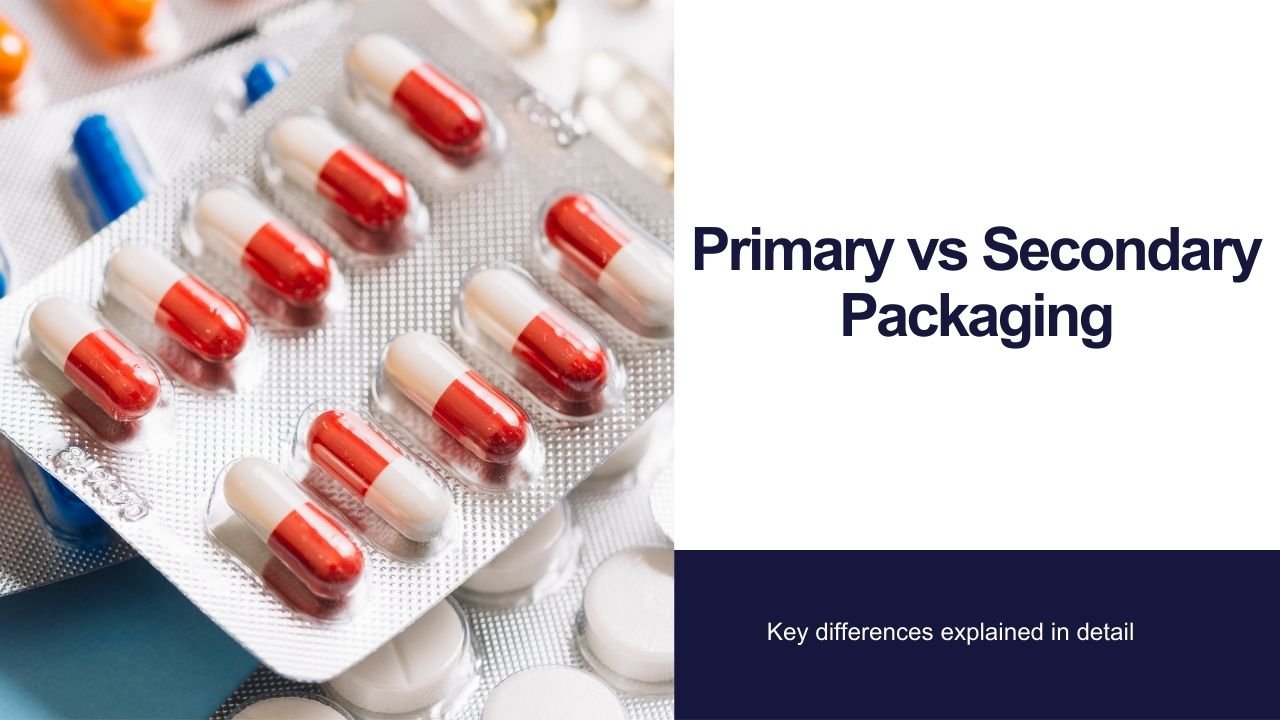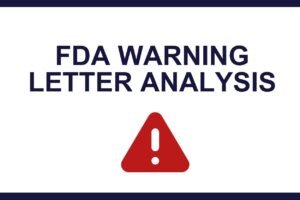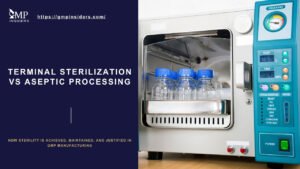In the pharmaceutical industry, packaging plays a critical role in protecting products, ensuring their stability, and providing essential information to users. Packaging encompasses components like bottles, vials, closures, caps, ampoules, and blisters that protect pharmaceutical products from production to use.
This article will focus on the characteristics and differences between primary and secondary packaging in the pharmaceutical industry.
What is Primary Packaging?
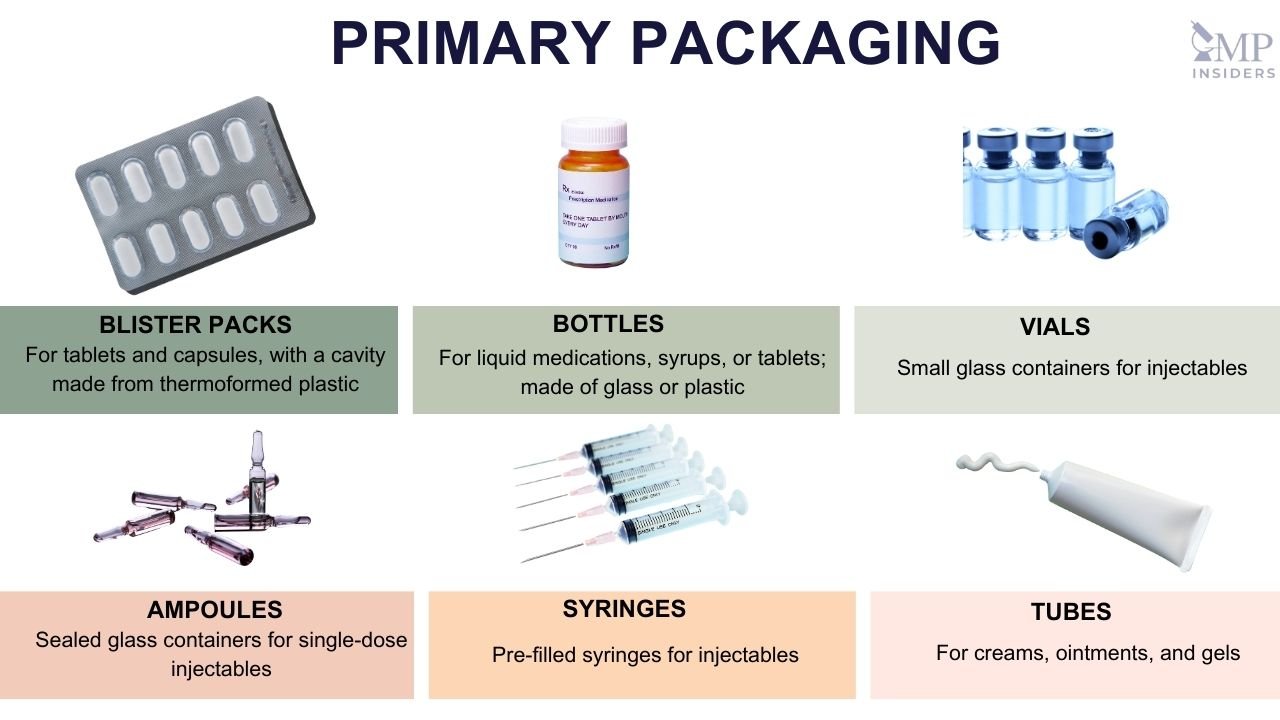
Primary packaging is packaging that comes into direct contact with the product. For example: blisters – the aluminum foil that comes into contact with the tablets or the capsules, and protects them from environmental factors (light, oxygen, temperature changes, gases, and moisture). Here the primary packaging not only enhances the appeal of the product, or eases its use, but also helps protect the medicine and holds its integrity until the expiry date.
Examples
What are other examples of primary packaging?
- Blister Packs: Used for tablets and capsules, consisting of a cavity or pocket made from a formable web, usually a thermoformed plastic.
- Bottles: Used for liquid medications, syrups, or tablets, typically made of glass or plastic.
- Vials: Small containers used for injectable drugs, usually made of glass.
- Ampoules: Sealed glass containers for single-dose injectable solutions.
- Syringes: Pre-filled syringes for injectables.
- Tubes: Used for creams, ointments, and gels.
How to Determine the Right Primary Packaging?
To determine the right primary packaging, the manufacturer must assess all product characteristics, such as formulation type (solid, semi-solid, liquid, or gas), stability (chemical and physical stability), sensitivity (is the product sensitive to moisture, oxygen, light, temperature) and sterility requirements (sterile or non-sterile product). If the product must be sterile, the manufacturer must decide on an appropriate sterilization method such as radiation, filtration, or autoclaving.
After that, comes the compatibility testing which includes:
- chemical stability (does the packaging material cause any potential degradation or contamination),
- physical stability (to ensure that the packaging holds the product’s integrity),
- material interaction (the packaging must not react with the product)
The manufacturer must determine the level of protection required against environmental factors, and choose the appropriate material for that level of protection (e.g. glass, metal, plastic).
Regulatory Compliance involves following relevant guidelines from regulatory bodies like WHO, FDA, and EMA.
The chosen packaging material must be easy to use (user-friendly) so the patient can easily open, dispense, and administer the medicine.
Steps to Determine the Right Primary Packaging
- Product Analysis
- Examine the specifications and characteristics of the product in depth.
- Determine the precise packaging requirements using the product’s stability data.
- Material Selection
- Consider the compatibility and protective qualities of various materials.
- Carry out compatibility tests to ensure the substance and the product don’t interact badly.
- Development of Prototypes
- Test prototypes in real-world scenarios, such as transportation simulations and stability testing.
- Regulatory Review:
- Examine the target market’s regulatory needs.
- Verify that the design and materials used for the package satisfy all legal requirements.
- User Testing
- Conduct usability tests to get input from end users, such as medical professionals and patients.
RELATED: The Importance of Pharmaceutical Packaging
Why is Secondary Packaging Important?
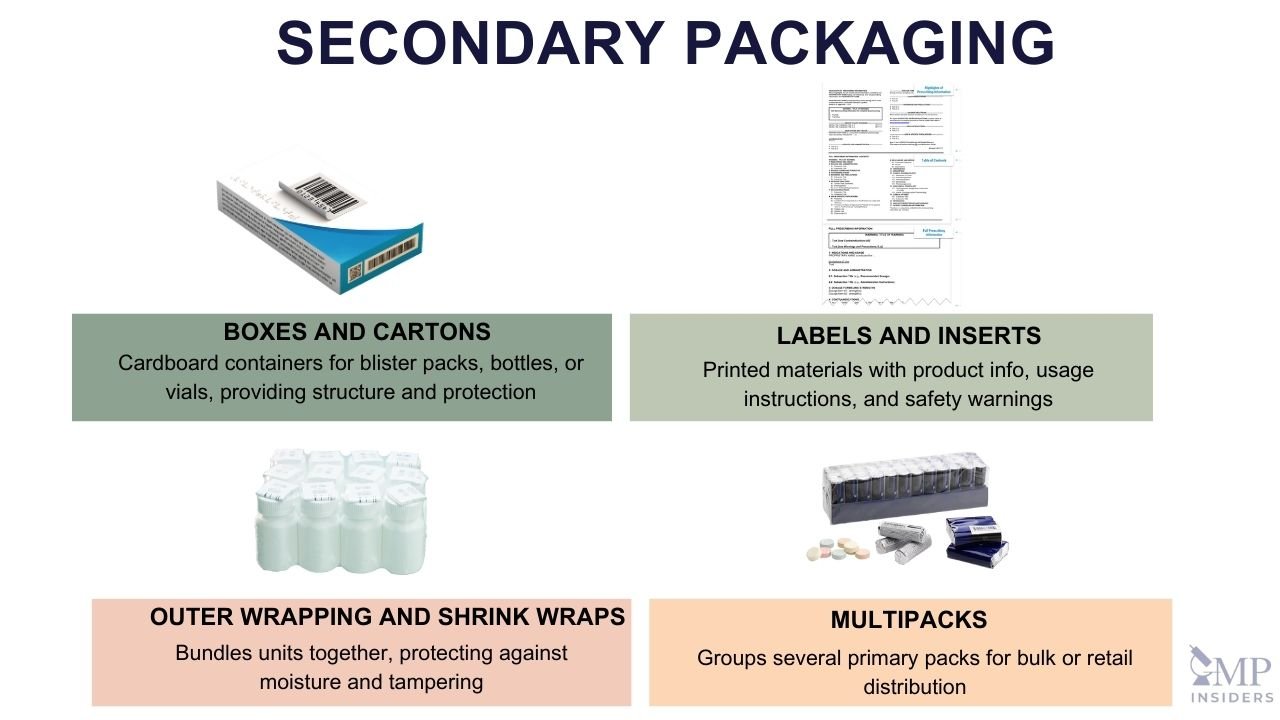
Secondary packaging does not come into contact with the product itself but is used to group and protect products that are already packed in primary packages. They are usually in the form of cardboard boxes and are used to protect, and enhance the appeal of the product for the customers and label all the necessary information about the product (name, how to use, dosage, and manufacturer)
This type of packaging contains names, logos, pictures, and colors to appeal to the customers. The more unique the packaging is the easier it is to be noticed by the client. Thus, the graphic designers need to design an inviting cover.
Examples
- Boxes and Cartons: Typically made from cardboard or similar materials, these are used to hold primary packaging units like blister packs, bottles, or vials. They provide structure and protection.
- Labels and Inserts: These include printed materials that provide critical information about the product, including usage instructions, safety warnings, and regulatory compliance data.
- Outer Wrapping and Shrink Wraps: Used to bundle multiple units together, these materials offer additional protection against moisture and tampering.
- Multipacks: Packaging several primary packs together, often used for bulk distribution or for retail packaging where multiple doses or units are sold together.
How to Determine the Right Secondary Packaging?
When deciding on the secondary packaging for the products, the following things should be taken into consideration:
- Assess Product and Primary Packaging:
Examine the features of the product and the security that the primary packaging offers. Determine the necessity for extra protection in light of the product’s sensitivity and the main packaging constraints.
- Choose the Right Materials:
Consider materials’ cost, durability, and environmental impact while choosing them. To make sure the material is compatible with the main container and product, test it.
- Create Prototypes:
Create secondary packaging prototypes that adhere to user, regulatory, and protection needs. Evaluate prototypes in real-world scenarios to gauge their effectiveness.
- Regulatory Review:
Examine the target market’s regulatory requirements, making sure that labeling, tamper-evident features, and other standards are met. Make sure the packaging has all the information that needs to be on it.
- User Testing:
Work with patients and other target users to conduct usability tests.
Primary vs Secondary Packaging: Key Takeaways
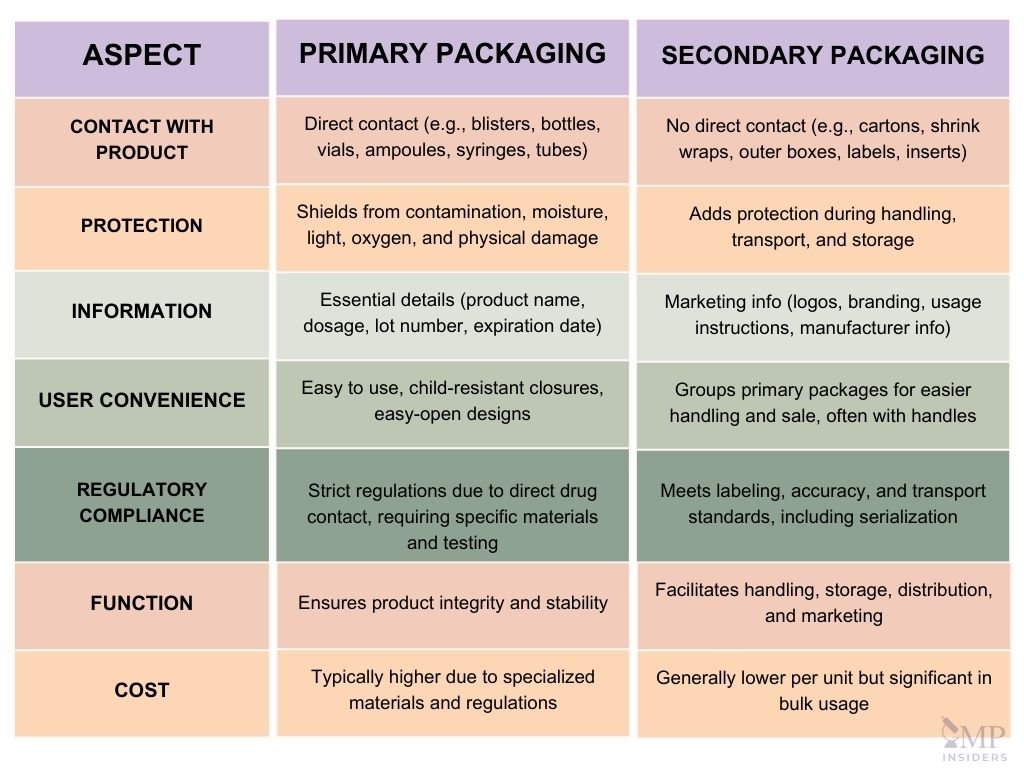
Some of the key differences between primary vs secondary packaging include:
Direct Contact with the Product
- Primary Packaging: Directly encases the drug product, ensuring protection from contamination, moisture, light, oxygen, and physical damage. Examples include blister packs, bottles, vials, ampoules, syringes, and tubes.
- Secondary Packaging: Does not come into direct contact with the drug product. It encases the primary packaging, facilitating handling, distribution, and sale. Examples include cartons, shrink wraps, outer boxes, labels, and inserts.
Protection and Preservation of the Product
- Primary Packaging: Provides essential protection and preservation of the drug product, maintaining its stability and shelf life by preventing exposure to harmful elements.
- Secondary Packaging: Accommodates primary packaging, offering additional protection against physical damage during transportation and storage, ensuring the primary packaging remains intact.
Information and Labeling
- Primary Packaging: Contains essential information about the product, such as the product name (common and generic), dosage, usage instructions, lot number, and shelf life. This information ensures proper use and regulatory compliance.
- Secondary Packaging: Provides space for marketing and additional product information, including logos, graphic designs, usage instructions, dosage information, shelf life, and manufacturer details, enhancing marketability and consumer information.
User Convenience
- Primary Packaging: Designed to facilitate ease of use and administration for end-users, often featuring child-resistant closures and easy-open designs to enhance user convenience and safety.
- Secondary Packaging: Groups multiple primary packages for easier handling, distribution, and sale. It often includes handles, easy-to-open designs, and informative labeling to improve user convenience and product accessibility.
Role in Drug Safety
- Primary packaging: Critical for drug safety as it directly protects the drug from contamination and degradation.
- Secondary packaging: Provides an additional layer of protection, ensuring the primary packages remain intact during transit and storage.
Impact on Supply Chain
- Primary packaging is designed for the immediate safety and efficacy of the drug, while secondary packaging facilitates the efficient handling, storage, and distribution of pharmaceuticals.
- Secondary packaging: Also plays a significant role in inventory management and tracking, ensuring that products are easy to locate and distribute within the supply chain.
Regulatory Considerations
Both primary and secondary packaging must comply with stringent regulatory requirements to ensure drug safety and efficacy. However, primary packaging is more heavily regulated due to its direct contact with the drug product. Regulations often mandate specific materials, labeling, and testing for primary packaging to ensure it does not interact negatively with the drug. Secondary packaging must also meet standards for labeling, information accuracy, and protection during transport.
The choice of materials used for primary/secondary packaging will depend on the required level of protection, compatibility with the contents, presentation of over-the-counter drugs (OTC), cost, filling method, usefulness of the packaging for the user such as method of opening and reclosing, size, weight.
Quality Control and Testing

Quality control and testing of primary and secondary packaging are critical components in ensuring the safety, efficacy, and integrity of pharmaceutical products. Below, we provide a detailed overview of the testing methods and requirements for both primary and secondary packaging.
Testing for Primary Packaging
Primary packaging directly contacts the product, making its integrity crucial for ensuring product quality and safety. Key tests include:
Container-Closure Integrity
Container-closure integrity Testing (CCIT) assesses the ability of the container-closure system to maintain a sterile barrier against potential contaminants. Common methods include:
- Microbial Ingress Testing: Determines if microorganisms can penetrate the packaging.
- Dye Ingress Testing: Uses colored dye to detect leaks.
- Vacuum Decay Testing: Measures the pressure change inside a vacuum chamber to detect leaks.
- Helium Leak Detection: Highly sensitive method using helium as a tracer gas to detect minute leaks.
Sterility Testing
Sterility Testing ensures that the product is free from viable microorganisms. It is a mandatory test for sterile products and involves:
- Direct Inoculation: Product samples are directly inoculated into culture media and observed for microbial growth.
- Membrane Filtration: The product is filtered through a membrane that captures any microorganisms, which are then cultured to check for growth.
Compatibility Studies
Compatibility Studies evaluate the interaction between the packaging material and the product to ensure there are no adverse effects. These studies assess:
- Chemical Compatibility: Testing for leachables and extractables from packaging materials.
- Physical Compatibility: Ensuring that the packaging material does not alter the product’s physical characteristics.
- Biological Compatibility: Verifying that the packaging does not impact the product’s biological activity.
Testing for Secondary Packaging
Secondary packaging provides additional protection and often includes labeling. Key tests include:
Durability Testing
Durability Testing ensures that secondary packaging can withstand handling, storage, and transportation conditions. Tests include:
- Compression Testing: Assesses the packaging’s ability to withstand stacking pressure.
- Drop Testing: Determines the packaging’s ability to protect the product from drops.
- Vibration Testing: Simulates transportation vibrations to ensure packaging integrity.
Transportation Testing
Transportation Testing evaluates the packaging’s robustness during distribution. It involves:
- Climatic Conditioning: Exposing the packaging to various environmental conditions (temperature, humidity) to test stability.
- Shock Testing: Simulating shocks during transit to ensure the packaging can protect the product.
- Incline Impact Testing: Simulating sudden impacts to assess the packaging’s protective capabilities.
Labeling Accuracy
Labeling Accuracy is crucial for regulatory compliance and user safety. This involves:
- Content Verification: Ensuring all necessary information is present on the label.
- Legibility Testing: Verifying that the text is clear and readable.
- Adhesion Testing: Ensuring labels remain attached under various conditions.
Regulatory Aspects for Primary and Secondary Packaging in Pharma Industry
Packaging pharmaceutical products is crucial for maintaining the quality and safety of the final product. It must protect against biological contamination, physical damage, and external factors such as oxygen, temperature variations, and moisture, while also ensuring correct information and product identification.
The chosen packaging must not adversely affect the product through chemical reactions, leaching, or the release of harmful substances, and it must retain its protective properties. Key interactions between the container and the product include the release of visible or non-visible particles, absorption of pharmaceutical components, degradation of packaging components, and release of chemical components from the packaging material. This includes rigorous testing for extractables and leachables to ensure no harmful substances migrate from the packaging into the product.
Extractables and Leachables
Extractables are chemical compounds that can be extracted from packaging materials under laboratory conditions. These substances may potentially migrate into the pharmaceutical product during its shelf life. Testing for extractables involves exposing the packaging materials to solvents and analyzing the extracted substances to identify potential risks.
Leachables are chemical compounds that migrate from the packaging into the pharmaceutical product under normal storage conditions. Leachables testing is critical to ensuring that these substances do not compromise the product’s safety, efficacy, or quality. Comprehensive E&L testing is mandated by regulatory agencies to detect any harmful substances that could affect patient health.
Aspects of Pharmaceutical Packaging
The packaging process includes several aspects: selection of materials, testing, sterilization, filling, assembling, storage, and stability. Containers can be primary or secondary, with classifications such as well-closed, tightly closed, hermetically closed, or light-resistant. The packaging process involves multiple stages and materials, including cardboard boxes, glass ampoules, plastic closures, and more.
Packaging Documentation and Special Types
Packaging documentation covers specifications and quality control, labels, inks, adhesives, and patient package inserts. Special packaging types include unit-dose packaging, which reduces medication errors and improves patient compliance, and “device” packaging, which facilitates easier administration through devices like prefilled syringes, droppers, transdermal systems, pumps, and aerosol sprays.
Key Functions of Pharmaceutical Packaging
- Containment: The primary function is to contain the product securely, considering the needs of the product and the manufacturing and distribution systems. It must be leak-proof, resistant to diffusion and permeation, and strong enough to handle normal conditions without altering due to the formulation’s ingredients.
- Protection: Packaging must protect the product from adverse external influences such as light, moisture, oxygen, biological contamination, and mechanical damage. Compatibility with active pharmaceutical ingredients is essential for maintaining product integrity.
- Stability: Real-time stability studies are conducted to assess changes in product quality during its shelf life. Packaging must preserve the physical properties of all dosage forms, protect against damage, maintain product identity, and prevent contamination.
Storage Conditions
Packaging must align with GMP standards for storage, considering the specific characteristics of active pharmaceutical ingredients. Different packaging requirements apply based on storage temperatures, light sensitivity, and sterility needs, ensuring the product remains safe and effective throughout its shelf life.
The shelf-life and utilization period are always determined concerning storage conditions and the stability of the active pharmaceutical ingredient. Normal storage conditions are defined as “storage in dry, well-ventilated premises at temperatures of 15-25°C or, depending on climatic conditions, up to 30°C.”
By adhering to these principles, pharmaceutical companies can ensure their packaging meets the highest standards of safety and quality, protecting both the product and the end consumer.
RELATED: Good Distribution Practices – GDP
Primary Packaging Guidelines
The requirements for primary packaging are covered in:
United States Pharmacopeia (USP)
USP <661> Plastic Packaging Systems and Their Materials of Construction: Covers plastic packaging systems for pharmaceuticals, including material safety, compatibility, and performance tests.
USP <381> Elastomeric Closure for Injections: Standards for elastomeric closures used in injectable products.
USP <660> Glass Containers: Glass containers for pharmaceutical use, including tests for hydrolytic resistance.
European Pharmacopoeia (EP)
EP 3.1 – Materials used for the manufacture of containers: Materials used for the manufacture of containers, specifying requirements for different types of plastic materials.
EP 3.2 – Containers: Containers and container closures, including specific requirements for glass, plastic, and rubber materials.
FDA Guidance
Container Closure Systems for Packaging Human Drugs and Biologics: Guidelines on the selection, evaluation, and use of container closure systems.
21 CFR Part 211: Current Good Manufacturing Practice (CGMP) regulations, including requirements for packaging and labeling control.
Secondary Packaging Guidelines
The requirements for secondary packaging are covered in the following guidelines:
FDA Guidance
21 CFR Part 211: Includes requirements for secondary packaging related to labeling and packaging controls.
Drug Supply Chain Security Act (DSCSA): Requirements for product serialization and traceability to prevent counterfeit drugs.
European Medicines Agency (EMA)
Guideline on the Packaging Information of Medicinal Products for Human Use: Requirements for the information that must appear on the outer packaging.
Falsified Medicines Directive (FMD): Regulations for serialization and safety features to combat counterfeit drugs.
International Organization for Standardization (ISO)
ISO 15378: Primary packaging materials for medicinal products – Particular requirements for the application of ISO 9001:2008, with reference to Good Manufacturing Practice (GMP).
Differences Between Primary, Secondary, and Tertiary Packaging
Tertiary packaging is different than the other two because the customers never see it. It is used to transport the goods from the manufacturer on pallets to distribution centers. This type of packaging is solely used for the transportation, storage, and shipping of the products. It consists of a few cardboard boxes filled with the product, wrapped with stretch wrap, to ensure that there are no damages to the final product.
FAQ
How Does Primary Packaging Affect Patient Compliance?
Primary packaging can significantly impact patient compliance. User-friendly designs, such as easy-to-open blister packs or clearly labeled bottles, can make it easier for patients to take their medication correctly and consistently.
How Does Secondary Packaging Contribute to Sustainability?
Secondary packaging can contribute to sustainability by using recyclable or biodegradable materials, reducing excess packaging, and optimizing packaging designs to minimize waste. Many companies are adopting eco-friendly practices to reduce their environmental impact.
How Do Environmental Factors Influence the Choice of Pharmaceutical Packaging Materials?
Environmental factors such as humidity, temperature, and light exposure significantly impact the selection of pharmaceutical packaging materials to ensure product stability and efficacy. Packaging must provide adequate protection against these elements, often leading to the use of specialized materials like blister packs, amber glass, and foil seals.
How Do Counterfeit Concerns Shape Pharmaceutical Packaging Strategies?
Counterfeit concerns drive pharmaceutical companies to adopt advanced packaging strategies that include tamper-evident features, unique serialization codes, and anti-counterfeiting technologies like holograms and RFID tags. These measures enhance product traceability and security, safeguarding both the brand and patient safety.
Final Thoughts
Primary and secondary packaging have different but equally important roles in the pharma industry. Primary packaging significantly affects the safety and effectiveness of the pharmaceutical product by ensuring its protection, stability, and appropriate distribution. In addition to offering extra protection, secondary packaging makes handling and distribution easier and fulfills crucial roles in marketing and legal compliance.
Strict regulations must be met by both kinds of packaging to guarantee that the pharmaceutical product’s safety and quality are not jeopardized. Careful design and material selection can improve sustainability, patient compliance, and the general user experience.
Understanding the distinctions between primary and secondary packaging, as well as their distinct uses, helps make decisions that will benefit patients, healthcare professionals, and manufacturers alike in a sector where maintaining product integrity is crucial.

